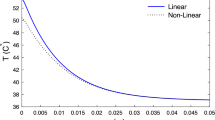The possibilities of describing structural couplings between the organs of a human being subjected to a treatment procedure of controlled whole-body hyperthermia at 43–44°C are considered. The requirements on a model that characterizes changes in the hemodynamics have been formulated, and the interrelations between the models of hemodynamics and heat transfer are shown. As an example of the implementation of the proposed approaches, a system of equations is given that describes heat exchange between an organism and a heat carrier, numerical simulation in the Matlab, toolbox Simulink medium is carried out, and the results of simulation are presented.
Similar content being viewed by others
References
F. V. Ballyuzek, M. F. Ballyuzek, V. I. Vilenskii, et al., Controllable Hyperthermia [in Russian], Nevskii Dialekt, St. Petersburg (2001).
S. R. Ash, C. R. Steinhart, M. F. Curfman, et al., Extracorporal whole body hyperthermia treatments for HIV infection and AIDS, ASAIO J., 43, No. 5, 830–838 (1997).
T. Feyerabend, G. J. Wiedemann, and R. Steeves, Advanced non-seminomatous germ cell cancer of the testis with brain metastases: feasibility of additional brain irradiation and whole body hyperthermia plus chemotherapy, Oncol. Rep., 8, No. 2, 219–223 (2001).
H. I. Robins, D. M. Katschinski, W. Longo, et al., A pilot study of melphalan, tumor necrosis factor-alpha and 41.8 degrees C whole-body hyperthermia, Cancer Chemother. Pharmacol., 43, No. 5, 409–414 (1999).
A. M. Westermann, E. A. Grosen, D. M. Katschinski, et al., A pilot study of whole body hyperthermia and carboplatin in platinum-resistant ovarian cancer, Eur J. Cancer, 37, No. 9, 1111–1117 (2001).
A. Zablow, L. M. Shecterle, R. Dorian, et al., Extracorporal whole body hyperthermia treatment of HIV patients, a feasibility study, Int. J. Hyperthermia, 13, No. 6, 577–586 (1997).
R. A. Vertrees, A. Bidani, D. J. Deyo, et al., Venovenous perfusion-induced systemic hyperthermia: hemodynamics, blood flow, and thermal gradients, Ann. Thorac. Surg., 70, No. 2, 644–652 (2000).
E. Lightfoot, Transfer Phenomena in Living Systems [Russian translation], Mir, Moscow (1977).
M. K. Sharp and R. K. Dharmalingham, Development of a hydraulic model of the human systemic circulation, ASAIO J., 45, No. 6, 535–540 (1999).
F. Yamazaki, K. Monji, Y. Sogabe, and R. J. Sone, Cardiac and peripheral vascular responses to head-up tilt during whole body thermal stress, UOEH, 22, No. 2, 147–158 (2000).
N. V. Kinsht and D. N. Kinsht, Mathematical modeling of systemic circulation and heat exchange in whole body hyperthermia (43–44oC), in: Proc. 5th Asian Control Conf. ASCC 2004, 20–23 July, 2004, Melbourne, Australia (2004), pp. 642–647.
O. I. Craciunescu and S. T. Clegg, Pulsatile blood flow effects on temperature distribution and heat transfer in rigid vessels, J. Biomech. Eng., 123, No. 5, 500–505 (2001).
D. N. Kinsht and N. V. Kinsht, Principles of heat transfer modeling in the case of whole body controllable hyperthermia, in: Proc. Int. Conf. “Computation and Information Technologies in Science, Engineering, and Education,” 7–9 October, 2004, Alma-Ata–Novosibirsk (2004), Vol. 9, Pt. II, pp. 342–345.
N. V. Kinsht and D. N. Kinsht, Mathematical simulation of heating a patient in the procedure of controllable whole body hyperthermia, in: Collected papers of the Int. Conf. “Infocommunicational and Computational Technologies in Science, Engineering, and Education,” 28–30 September, 2004, Tashkent (2004), pp. 217–220.
B. Folkov and É. Nil, Blood Circulation [in Russian], Meditsina, Moscow (1976).
P. Johnson, Peripheral Blood Circulation [Russian translation], Meditsina, Moscow (1982).
D. Morman and L. Heller, Physiology of the Cardiovascular System [Russian translation], Piter, St. Petersburg (2000).
N. V. Kinsht, G. N. Gerasimova, and M. A. Kats, Diagnostics of Electric Circuits [in Russian], Énergoatomizdat, Moscow (1983).
Author information
Authors and Affiliations
Corresponding author
Additional information
Translated from Inzhenerno-Fizicheskii Zhurnal, Vol. 81, No. 6, pp. 1188–1197, November–December, 2008.
Rights and permissions
About this article
Cite this article
Kinsht, N.V., Kinsht, D.N. Hemodynamics and heat transfer in controlled whole-body hyperthermia: modeling of processes. J Eng Phys Thermophy 81, 1232–1241 (2008). https://doi.org/10.1007/s10891-009-0142-8
Received:
Revised:
Published:
Issue Date:
DOI: https://doi.org/10.1007/s10891-009-0142-8




